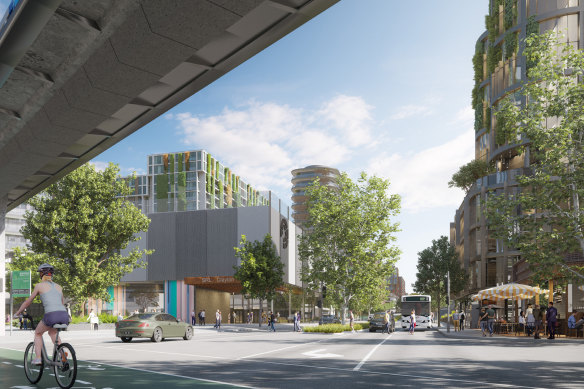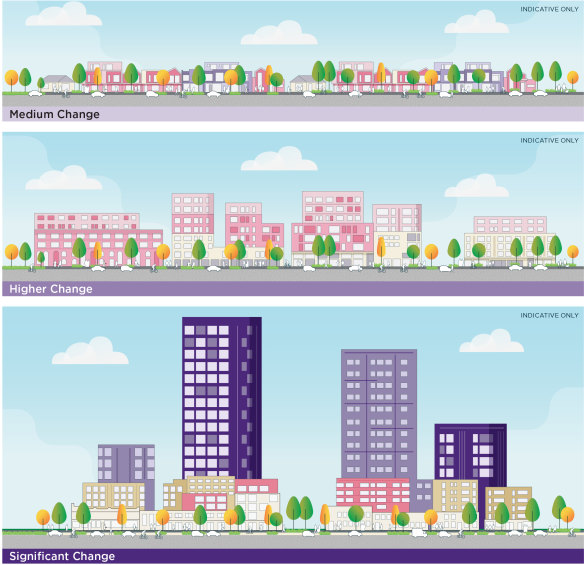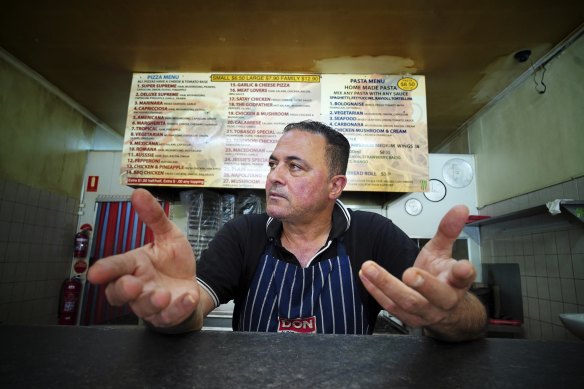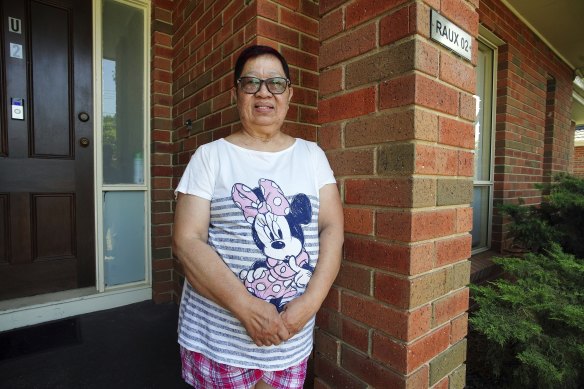Towering housing and office blocks would be built directly above Suburban Rail Loop East stations, and the surrounding streets would become unrecognisable hubs for apartments and jobs under a detailed vision of how the $34.5 billion project proposes to reshape Melbourne’s skyline.
A “draft precinct vision” released for community consultation on SRL East’s first stage – an underground railway between Cheltenham and Box Hill – provides the clearest picture yet of how things would change. By 2056, it is predicted there will be twice as many residents and jobs crammed into a 1600-metre radius around each of the six new stations.

An artist impression of how the area around the SRL’s Clayton station might look.
Stations will be built in the suburbs of Cheltenham, Burwood, Glen Waverley and Box Hill and there will be two in Clayton, including one at Monash University.
The new maps and documents will underpin more detailed precinct plans early next year. The draft shows – down to the street level – where blocks of high-density development will likely be allowed, split into three area categories: significant change, higher change and medium change.
They do not name a specific height requirement for each area, however artist impressions and picture book-style illustrations from the plans show how each zone “could look and feel like in the future”.
The drawings suggest towers of about 20 storeys in Clayton, Box Hill, Monash and Glen Waverley’s significant change areas, eight storeys in higher-change areas and double or triple-storey townhouses in medium-change areas.

The draft shows possible areas of high-density development split into three categories.
Plans for the stations at Burwood and Cheltenham show smaller towers would be proposed in their densest sections, about half the height of other precincts.
The vision for Clayton maps out a significant change zone covering either side of Clayton Road, north of Clayton station and connecting to the Monash Medical Centre. The area is now mostly occupied by single and double-storey shops, restaurants and detached homes.
Higher change development, which could be up to eight stories high based on the illustrations, stretches out along Clayton Road, Centre Road, and North Road.
That area will “concentrate the densest opportunities for employment in a mixed-use neighbourhood that will include taller buildings and upgraded public spaces” and will “enable quality social and affordable housing and well-designed student and key worker accommodation close to Monash University and hospitals in both Clayton and Monash”, the vision says.

Jessie’s Pizza owner Sanan Shaana.Credit: Luis Ascui
Sanan Shaana owns Jessie’s Pizza on Clayton Road, part of a small shopping strip that will be bulldozed to make way for the new Clayton underground station. Under the draft vision, the single and double-storey shopfronts would be replaced by high rises.
The Suburban Rail Loop Authority bought the building from Shaana’s previous landlord and has given him until March to leave.
Shaana – who has worked in the pizza shop for 22 years and bought the business in 2009 – said he couldn’t afford the $100,000 needed to lease and fit-out a new store. He has sold his house because he won’t be able to cover his mortgage payments when his business shuts.
“Sometimes I can’t sleep, I’m just thinking, ‘March is coming, what can I do after? How can I manage?’” he said. “They’re stealing my business in front of my eyes. I’ll lose everything.”
A government spokesperson said Jessie’s Pizza was eligible for support via planning advice and business mentoring – but not financial compensation because he was on a year-to-year lease.
“We are working closely with owners and tenants and aim to minimise acquisition, however delivering this city-shaping project means that some impacts are unfortunately unavoidable,” the spokesperson said.
On Madeleine Road, a suburban street on the border of Clayton’s proposed significant change area, about half-a-dozen freestanding houses acquired for the project are already vacant and boarded up, awaiting demolition.
Residents said that while they knew about the new underground station being built, they had no idea that high-rise apartment buildings could follow.

Clayton resident Leila Mercado said she was not aware that high rises would be built in here area alongside the rail loop.Credit: Luis Ascui
“I was shocked because I’ve been getting letters and there’s been people from the Suburban Rail Loop here talking about what’s going to happen with the plans and the route where the train is going,” said Leila Mercado, who has lived with her adult children on Madeleine Road for about three years. “But they never ever said anything about apartments.”
Mercado predicted many residents would move out if there was significant development in the area.
The authority’s draft vision for Glen Waverley details a swathe of high-density commercial buildings along Snedden Drive, south of High Street Road. It has also been proposed to provide corridors of green space and bike paths in the surrounding streets to support this high-rise hub.
Monash Mayor Nicky Luo said the council was reviewing the draft precinct documents for the four stations in its boundaries and would make a submission in early 2024.
“Whilst this transformational project has the support of council, we have previously expressed reservations about the precinct planning process, in particular the provision of planning powers to the Suburban Rail Loop Authority, the size and intensity of development and impacts on existing neighbourhoods,” she said.
“It is important that planning for these precincts focuses development and density in appropriate areas around the SRL station precincts.”
Whitehorse Mayor Denise Massoud said the council had been advocating for broader community consultation and for the authority to enter a “collaborative partnership” with it for plans at Burwood and Box Hill. She said the council wanted to “ensure the plans reflect local community needs and give due consideration to open space, environment, amenity, liveability and our local economy”.
RMIT Centre for Urban Research director Professor Jago Dodson said the Suburban Rail Loop Authority would have planning powers over station precincts alongside laws allowing for levies, charges and financial deals that would help their goal of funding a third of the project through value capture.
“One would assume that they’ll be using those [powers], to the full extent they can to maximise the benefit of development,” he said.
“The question will really be when it comes to the actual physical built environment that’s being developed and the extent to which residents have input into those processes.
“I don’t think they’re going to quite achieve the notion of Hong Kong or Shanghai-style concentrated development around the station in the very short term. The prospect of that kind of scale of development or that typology of development is a very, very long-term pattern.”
Dodson said the authority would have a say in as much as half of the residential area in some areas.
“Giving it to a separate planning body that doesn’t have direct democratic input from the electorate – that’s a pretty substantial change,” he said.
Opposition planning spokesman James Newbury said the SRL precincts were being used to “take a wrecking ball through our suburbs”.
“The solution to the housing crisis is a proper plan for our state’s future, not taking away local planning decisions and imposing high-rise towers right across our communities,” he said.
Consultation on the draft vision has received more than 1000 responses so far.
An authority spokeswoman said: “The Suburban Rail Loop will shape how Melbourne grows – extensive feedback from the community and careful planning will ensure this project transforms our public transport system for the better.
“The areas around SRL stations will be vibrant communities, close to jobs and services – and we have begun the planning process to make sure these communities maintain their existing neighbourhood character while increasing housing choices to meet demand.”
https://news.google.com/rss/articles/CBMigwFodHRwczovL3d3dy50aGVhZ2UuY29tLmF1L3BvbGl0aWNzL3ZpY3RvcmlhL3RoZS1maXZlLXN1YnVyYnMtc2V0LXRvLWNsaW1iLXNreS1oaWdoLXdpdGgtdGhlLXN1YnVyYmFuLXJhaWwtbG9vcC0yMDIzMTIyNy1wNWV0dTAuaHRtbNIBAA?oc=5
2023-12-27 18:00:00Z
CBMigwFodHRwczovL3d3dy50aGVhZ2UuY29tLmF1L3BvbGl0aWNzL3ZpY3RvcmlhL3RoZS1maXZlLXN1YnVyYnMtc2V0LXRvLWNsaW1iLXNreS1oaWdoLXdpdGgtdGhlLXN1YnVyYmFuLXJhaWwtbG9vcC0yMDIzMTIyNy1wNWV0dTAuaHRtbNIBAA
Bagikan Berita Ini














0 Response to "The five suburbs set to climb sky-high with the Suburban Rail Loop - The Age"
Post a Comment